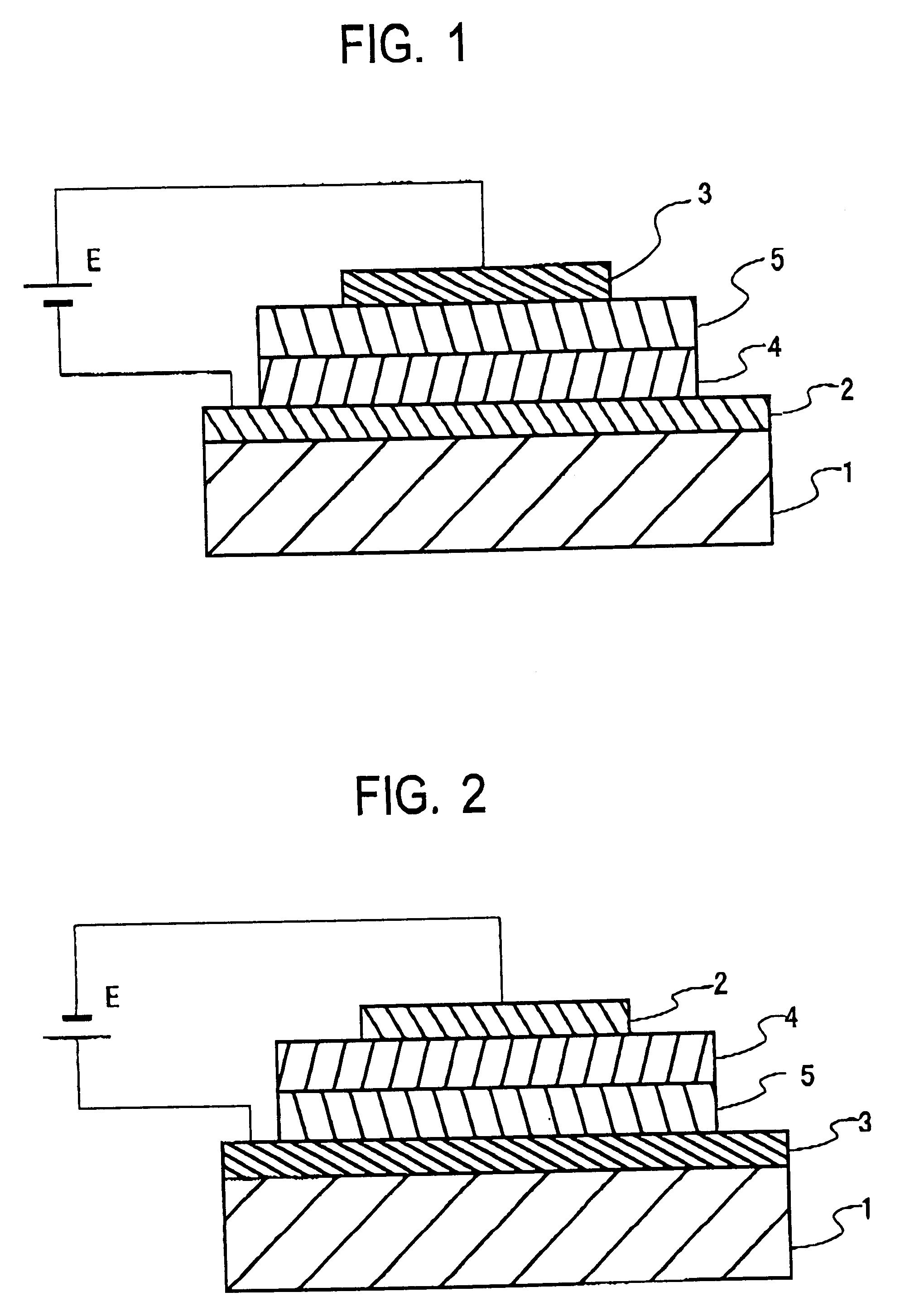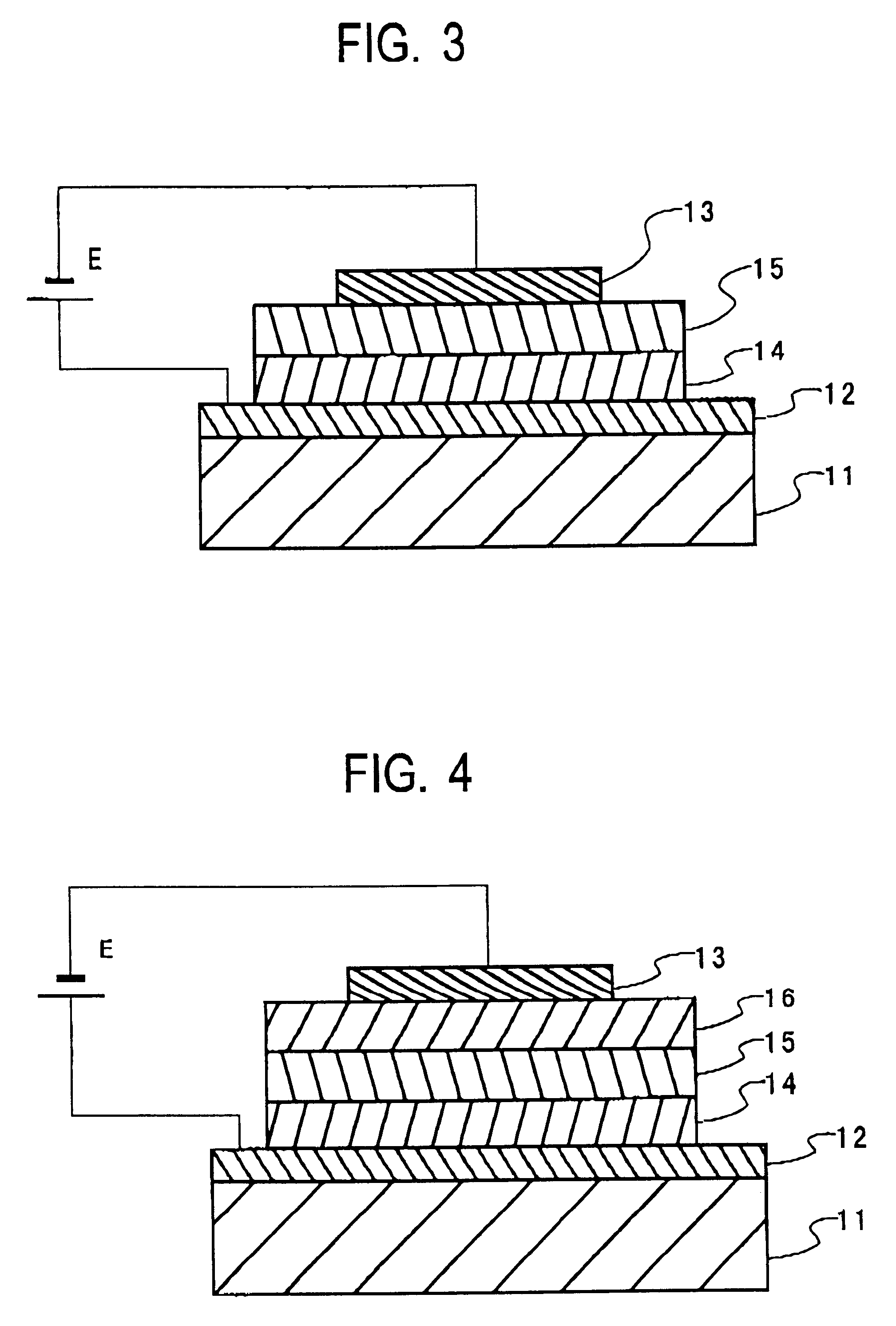Organic electroluminescent device
an electroluminescent device and organic technology, applied in the direction of discharge tube/lamp details, discharge tube luminescnet screens, organic semiconductor devices, etc., can solve the problems of high cost, high cost, and high cost of devices, and achieve the effect of maintenance, reducing the cost of production, and improving the reliability of devices
- Summary
- Abstract
- Description
- Claims
- Application Information
AI Technical Summary
Benefits of technology
Problems solved by technology
Method used
Image
Examples
example 1
A 7059 substrate (made by Corning) used as a glass substrate was scrubbed with neutral detergent.
Then, the substrate was fixed to a substrate holder in a vacuum evaporation system, which was evacuated to a vacuum of 1.times.10.sup.-4 Pa or lower. With the vacuum kept, Al was deposited by evaporation to a thickness of 200 nm thereby forming a cathode.
With the vacuum still kept, the substrate with the cathode formed thereon was transferred into a sputtering system where an inorganic insulating electron injecting layer was formed to a thickness of 1 nm, using as a target a mixture of strontium oxide (SrO) and 25 mol % of hafnium oxide (HfO.sub.2). Regarding the film formation conditions applied to this end, the substrate temperature was 25.degree. C., a mixture of Ar and O.sub.2 at 1:1 was used for the sputtering gas, the film formation rate was 1 nm / min., the operating pressure was 0.5 Pa, and the input power was 5 W / cm.sup.2.
With the vacuum still kept, N, N, N', N'-tetrakis(m-bipheny...
example 2
An organic EL device was prepared as in Example 1 with the exception that the inorganic insulating electron injecting layer was formed using strontium oxide (SrO) as the oxide having a low work function and cerium oxide (Ce.sub.2 O.sub.3) as the oxide having a high work function.
When this organic EL device was continuously driven with a constant current of 100 mA / cm.sup.2 as in Example 1, the initial luminance was equivalent to that of Example 1. Even after the passage of 300 hours, at least 80% of the initial luminance was still kept. In the organic EL device of this example, neither current leakage nor dark spots were observed.
example 3
Organic EL devices were prepared as in Example 1 with the exception that electron injecting layers were formed using as the oxide having a low work function lithium oxide (Li.sub.2 O), sodium oxide (Na.sub.2 O), potassium oxide (K.sub.2 O), rubidium oxide (Rb.sub.2 O), cesium oxide (Cs.sub.2 O), calcium oxide (CaO), barium oxide (BaO), and yttrium oxide (Y.sub.2 O.sub.3) instead of strontium oxide (SrO). The same effect as in Example 1 was obtained.
Organic EL devices were prepared as in Example 1. Instead of hafnium oxide (HfO.sub.2), however, beryllium oxide (BeO), magnesium oxide (MgO), titanium oxide (TiO, TiO.sub.2), iron oxide (FeO), zirconium oxide (ZrO.sub.2), lanthanum oxide (La.sub.2 O.sub.3), praseodymium oxide (Pr.sub.2 O.sub.3), neodymium oxide (Nd.sub.2 O.sub.3), samarium oxide (Sm.sub.2 O.sub.3), europium oxide (Eu.sub.2 O.sub.3), gadolinium oxide (Gd.sub.2 O.sub.3), terbium oxide (Tb.sub.2 O.sub.3), dysprosium oxide (Dy.sub.2 O.sub.3), holmium oxide (Ho.sub.2 O.sub.3)...
PUM
 Login to View More
Login to View More Abstract
Description
Claims
Application Information
 Login to View More
Login to View More - R&D
- Intellectual Property
- Life Sciences
- Materials
- Tech Scout
- Unparalleled Data Quality
- Higher Quality Content
- 60% Fewer Hallucinations
Browse by: Latest US Patents, China's latest patents, Technical Efficacy Thesaurus, Application Domain, Technology Topic, Popular Technical Reports.
© 2025 PatSnap. All rights reserved.Legal|Privacy policy|Modern Slavery Act Transparency Statement|Sitemap|About US| Contact US: help@patsnap.com



